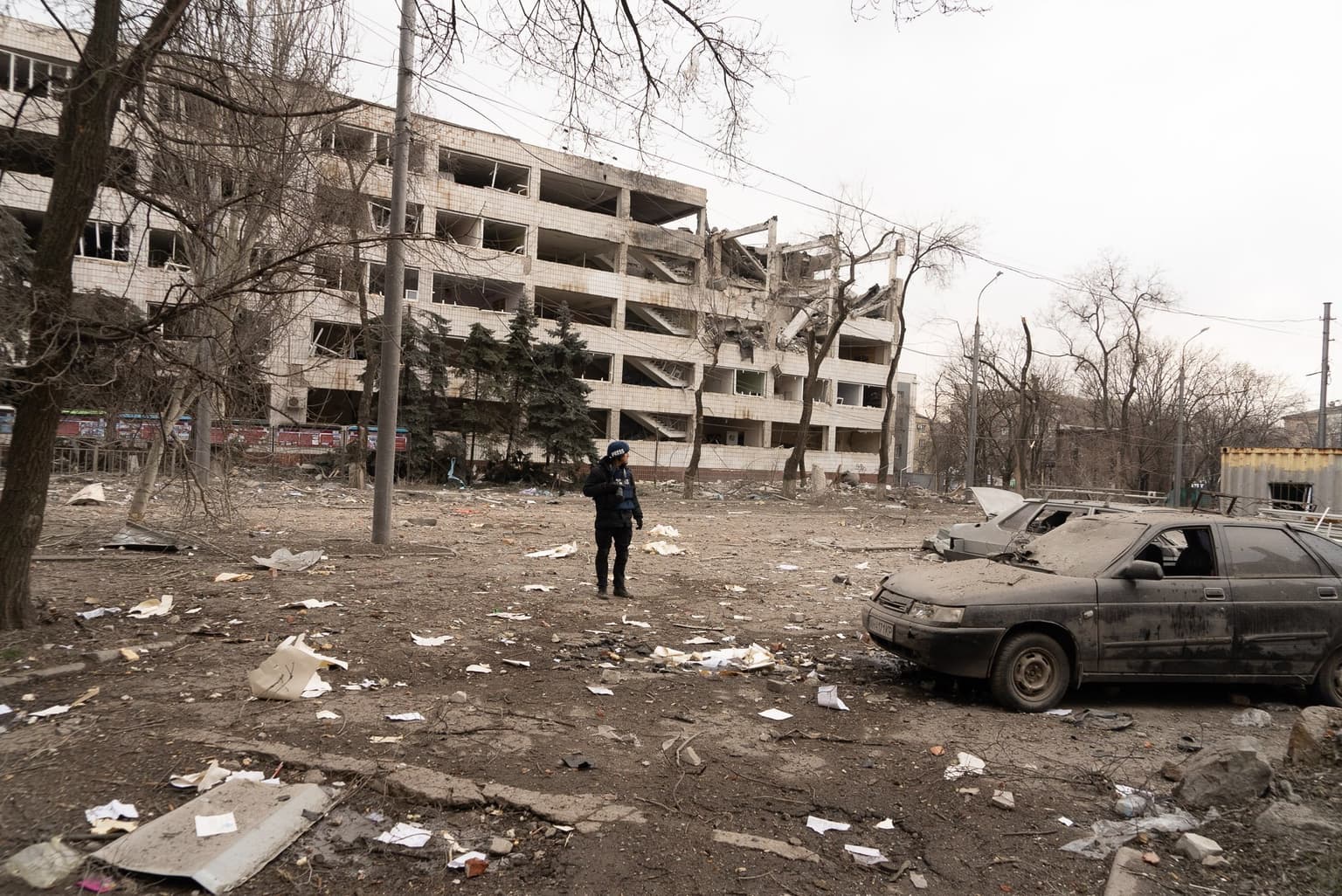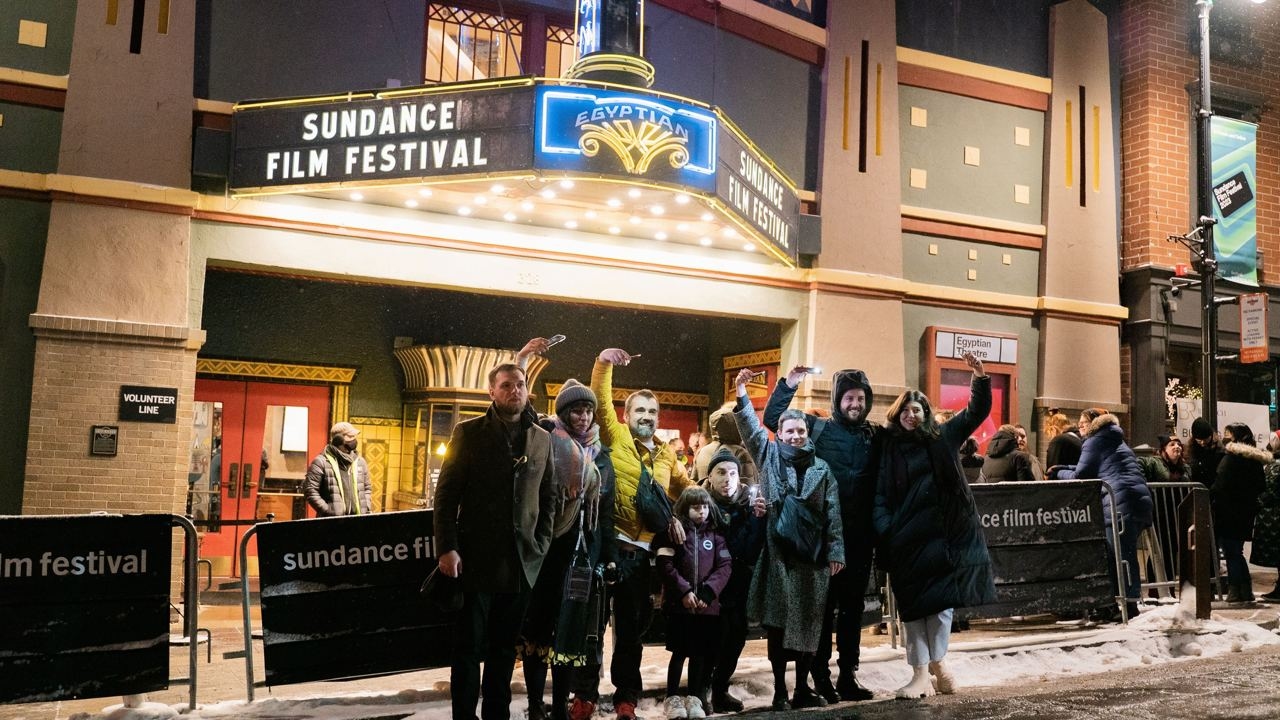Ukrainian filmmakers center resilience, horrors of war at Sundance Film Festival

The first Russian bomb hit the outskirts of Mariupol an hour after video journalist Mstyslav Chernov arrived to the city on Feb. 24, the first day of the full-scale Russian invasion of Ukraine. For 20 days that followed, Chernov’s team captured Russian blows strangling the city block by block.
Nine months later, Chernov turned 30 hours of footage into the documentary feature "20 Days in Mariupol.” The film premiered at the Sundance Film Festival in late January, where it picked up the Audience Award in the World Cinema Documentary Category.
It was screened at the biggest U.S. independent film festival together with other Ukrainian films "Klondike,” "Liturgy Of Anti-Tank Obstacles,” and "Iron Butterflies.”
Chernov and two other journalists, Evgeniy Maloletka and Vasilisa Stepanenko, remain mostly off-screen as the audience views the destruction of Mariupol through their cameras. The narration offers context for the gripping photos, taken by the team for the Associated Press, which the world has seen in real time as the Russian military sieged the city.
Chernov, who wrote, directed, and produced the movie said he wanted to go “beyond the news headlines or 30-second-long videos for newsreels” by turning to a documentary feature format.
The audience watches Mariupol residents as they hide in bomb shelters, lose loved ones, and work around the clock to help the wounded, opening up to the journalists at their most vulnerable moments. At one point in the movie, the audience rides along with a police officer who risks his life to help the team send materials to the editors, believing that if published, the pictures may change the outcome of the war.
In bringing the story to the screen, Chernov had to re-live the horrifying moments, deciding how much graphic content his audience could take before they turn away.
“Together with the film editor, I sat in a small room and watched these videos for an entire year. Every detail remains in front of my eyes,” Chernov said. “At Sundance, the film editor (Michelle Mizner) said she had never cried as much as she did when working on this film.”
Despite the grave danger, the Ukrainian team decided to stay in Mariupol after the beginning of the full-scale invasion for as long as possible.
“We had the responsibility to continue despite everything and do all we can to document the history of Ukraine because Mariupol isn’t just a city, it’s a symbol of Ukrainian resistance,” Chernov said.
Directors across categories also centered on Ukrainian resilience, not only in the last year but since Russian aggression began in 2014.

Workshop of the Ukrainian sculptors in Lviv Oblast who turned to create anti-tank obstacles after the full-scale Russian invasion of Ukraine in 2022 in the documentary “Liturgy of Anti-Tank Obstacles.” (Photo: Sundance Film Festival)
In “Liturgy of Anti-Tank Obstacles,” director Dmytro Sukholytkyy-Sobchuk relies on symbols to show the unity of the Ukrainian people in defending their country. The 12-minute documentary takes the audience to the workshop of the religious sculptors that started making anti-tank obstacles after the full-scale invasion. Sukholytkyy-Sobchuk got to capture the perspective by relying on his friends among the artists and sculptors.
Daniel Lombroso, who produced the film for The New Yorker, started to work on the project following the “journalistic impulse to cover the war in a meaningful way.” While capturing how life in Ukraine changed for the magazine, Lombroso insisted on supporting independent Ukrainian filmmakers, who could look beyond the big headlines.
“You can show the texture of life and feel the presence of the war without showing it,” Lombroso said of Sukholytkyy-Sobchuk’s directing. “It was a vision of the war that I hadn’t seen and I think very few people had seen.”
The realities of war seeped into the filmmaking process as Sukholytkyy-Sobchuk would call Lombroso from bomb shelters during air raid alerts. As the two exchanged edits, they seeked compromise between Lombroso’s character-driven narratives and Sukholytkyy-Sobchuk’s meditative shots.
“When you watch Dmytro’s film it’s sort of like a New Yorker article brought to life. It’s so subtle. It’s not a conceptual film, it’s metaphorical — it’s about the cross,” Lombroso said. “When you turn the cross at its side, it becomes an anti-tank obstacle, that’s the visual metaphor at the heart of the film and it takes a lot of patience to get there.”
While Sukholytkyy-Sobchuk couldn’t join the Sundance screening due to visa delays, Lombroso represented the movie in Utah. The movie is a part of the magazine’s three-part series showcasing Ukrainian filmmakers’ personal takes on life during the war.
“He has the ability to make a historic war film without showing a single image from the war, at least of any death,” Lombroso said. “I think that shows a lot of courage as an artist.”

The team of the Ukrainian documentary “Iron Butterflies” before presenting the movie at the Egyptian Theater at the Sundance Film Festival in Utah on Jan. 22, 2023. (Photo: Courtesy of Polina Buchak)
The willingness to take creative risks is evident in another Ukrainian entry, “Iron Butterflies,” directed by Roman Liubyi. By combining open-source video footage with physical theater and choreography, he tells the story of the Malaysia Airlines flight MH17, when a commercial plane was shot down over Ukraine amid the Russian invasion in the east in 2014, killing all 298 people on board.
The premiere comes two months after The Hague District Court found a Russian-controlled proxy group guilty of shooting down the plane. According to the Joint Investigation Team report published on Feb. 8, there are "strong indications" that Russian dictator Vladimir Putin supplied the missile that downed the aircraft.
Liubyi began the project in 2019 as a part of the Ukrainian Babylon ’13 collective, which describes its mission as changing society through cinema.
“As an activist, I wanted to tell a story about a war crime and speak about propaganda and how it works,” Liubyi said. “As an artist, I wanted to share what (most) Ukrainians probably feel about this case.”
Some of the feelings were personal. The ending of the movie connects the international inaction following the MH17 tragedy to the full-scale Russian invasion. In the movie, Liubyi included shots of Ukrainians crossing a destroyed bridge half a mile from his parents’ home to get to safety, just like his wife and daughter did in March of 2022.

The daughter of director Roman Liubyi plays with the butterfly-shaped shrapnel representing the artifacts found after the MH17 plane was shot down by Russia's proxies over Ukraine in the documentary “Iron Butterflies.” (Photo: Sundance Film Festival)
Experimental filmmaking captured the moments that left Ukrainians with a “horrible and complex mixture of feelings that’s hard to describe with words” after the destruction of hundreds of lives with “just one push of a button.”
“The style of Ukrainian poetic cinema is not something that we as filmmakers try to follow. It is just how we make films,” Liubyi said.
As the festival season continues, the director hopes to use the spotlight to benefit his country with the next stop at the Berlin International Film Festival.
“You can’t defend yourself from the rocket with the film, even if it’s the best film ever. It’s about parallel warfares,” Liubyi said. “I need to somehow take everything I can from media warfare to help the guys who are dealing with the real war.”
Presenting alongside other Ukrainian directors, Liubyi felt like a part of a single team, like “all these projects are a part of one puzzle.”

The main character, Irka, sitting next to a brick wall crumbling after a strike by Russian-armed militants in the east of Ukraine in “Klondike.” (Photo: Klondike)
Another part of the puzzle, “Klondike,” premiered at Sundance last year and won the Directing Award in World Cinema Dramatic Competition. After winning the Prize of Ecumenical Jury at the Berlin International Film Festival in 2022, its director Maryna Er Gorbach returned to Utah for an anniversary screening this year.
The movie connects the story of the foreigners who have lost family members in the MH17 crash with the story of a Ukrainian family living in the Russian-occupied eastern Ukrainian village, Hrabove, where the tragedy took place. In the movie punctuated by the life periods of a young family, every stage is upended by a war-related event.
“There was no other alternative to describe the rhythm of my feeling of the catastrophe unraveling in Donbas except for letting the life run its course through the periods,” Er Gorbach said.
Since the movie premiered before the full-scale invasion, people would often ask her why the main character stays in an occupied home. Since Feb. 24, many have seen other Ukrainians make the same decision in the face of Russian aggression.
“Clearly, this is about protecting your territory,” Er Gorbach said. “Sometimes staying in your home isn’t about not knowing where to go, it is about the principled stance, even without slogans, to plan your future where you live.”
Er Gorbach views the three Ukrainian feature films at Sundance as pieces to the multidimensional story spanning the beginning of the Russian aggression, the feelings of Ukrainians, and previous mistakes of the international community.
“Almost all of us who did a Q&A at Sundance talked about the international ignorance and the resistance to characterize the occupation (in 2014) as a crime against an independent country,” Er Gorbach said.
In the year since its Sundance premiere, “Klondike” has been released in Ukraine, Turkey, Brazil, and Taiwan. In the upcoming months, audiences in Italy, Germany, Japan, and the U.S. will also get a chance to see the movie.
Er Gorbach believes that one of the movie’s main insights lies in showing people looking for a sense of normalcy in the face of “all of the catastrophe, tragedy, and surrealism.”
On the aesthetic level, Er Gorbach avoids “the propaganda of war imagery,” minimizing the violent scenes. Similar to the other Ukrainian entries, she wanted the audience to feel the catastrophe as it seeps into her character’s breathing, in the darkened clouds over the horizon, and in the brick wall crumbling under a strike.
These movies are not available on streaming services as of Feb. 9, 2023.
___________________________________________________________________________________________________________________________
Note from the author:
Hi, it’s Anastasiia Malenko. Thank you for reading my story. The Kyiv Independent has covered the war in all its aspects, from reporting on front-line developments to writing about efforts to save the Ukrainian culture. Our team is always looking for stories that help our readers understand Ukraine and go beyond the big headlines. We rely on your support to continue our work. Please consider joining our community.










